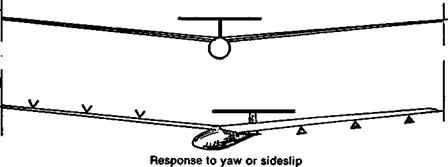SPINNING
Spinning is caused by stalling of the main wing in an asymmetrical fashion as shown in Figure 12.19. In a fully developed spin, the whole wing is stalled but one side is further* beyond the stalling angle than the other, which causes that wing to drop and ‘auto – rotation’ of the model follows with a high rate of descent. To recover, the rotation must be stopped and the wing unstalled, usually requiring both elevator and fin or rudder action. Models differ widely in their spin characteristics and some cannot be made to spin at all.
![]()


small dihedral does not require complex structure
polyhedral: practical and effective
ideaі elliptical form : structure difficult
![]()
|
These are usually models with large fin areas and centre of gravity well forward. Wings with generous tip chords and washout are less likely to drop a wing when stalling, and so are less likely to enter a spin. For aerobatics, strongly tapered wings without washout and small fins promote entry to spins and a rearward c. g. will help to maintain the spin. Of course these features, if overdone, may also prevent recovery. If the c. g. is too far aft, a ‘flat spin’ may result, with no possibility of recovery.
If, during a spin, the rudder and fin are blanketed by the disturbed flow over the tailplane, recovery may be impossible. The rudder as far as possible should be mounted below the tailplane or in one of the positions suggested in Figure 12.19. A fully aerobatic model may be required to spin inverted. In this case the rudder might be disposed equally above and below the tailplane and if possible ahead of it or well behind. A low aspect ratio fin, as mentioned in Chapter 5, is desirable for spin recovery.
The position of ailerons in spinning, and in entry and recovery, will vary from model to model. In some cases entry to the spin is aided by ailerons applied against the intended direction of spin. This increases the aerodynamic angle of attack on the ‘down’ aileron side and since a cambered aerofoil reaches its stalling angle sooner (see Fig. 7.4 and 13.2) this wing may stall first and initiate the spin. In other cases, especially with broad chord wing tips, the ailerons continue to work in their normal sense even beyond the stall, in which case aileron opposed to the spin direction may prevent entry or even precipitate spinning the other way. The same applies during recovery. No general rule can be laid down, each model must be investigated and the best procedures found.











